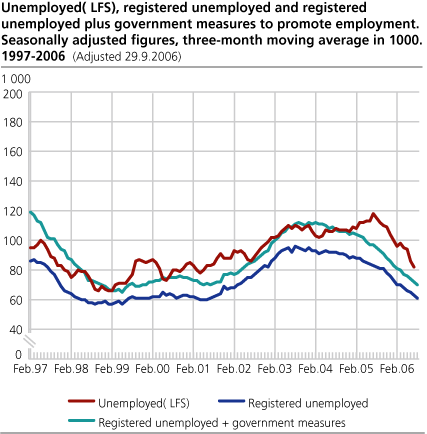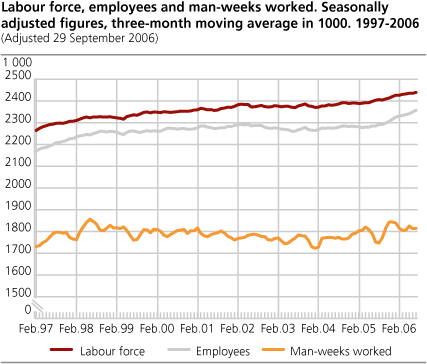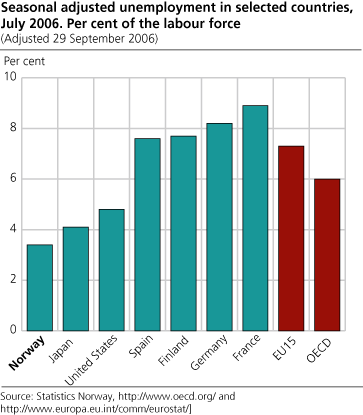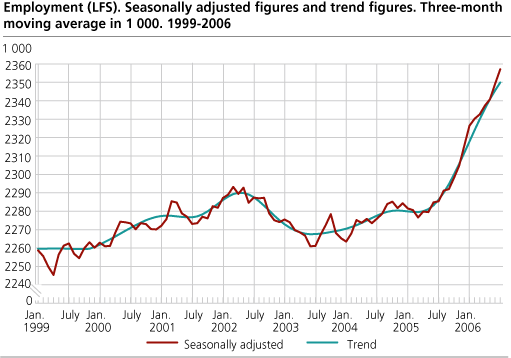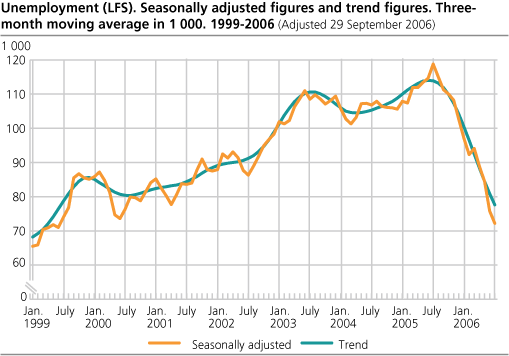Content
Published:
This is an archived release.
Continued labour market improvement
From April to July, employment rose by 20 000, while unemployment fell by 13 000 people. The figures presented in this article are adjusted for seasonal variations. Due to errors in the unemployment figures for the months in 2006, the previous published decline in unemployment of 17 000 people has been corrected to 13 000. Corrected 15:40 29.09.2006
|
Error in unemployment figures for 2006
Due to a mistake, a specific group of people has been excluded from the previously published 2006 unemployment figures.
|
This led to an unemployment rate of 3.4 per cent of the labour force in July, and not 3.0 per cent (previously published). The decline in unemployment from April (the March-May period) to July 2006 (June-August) is consistent with the development since the summer of 2005. The last bottom level was in the beginning of 1999. The seasonally adjusted unemployment rate then was 2.8 per cent.
Seasonally adjusted figures of registered unemployment at job centres show a decline of 5 000 people from April to July 2006.
Employment increased by 20 000 people from April to July 2006, according to seasonally adjusted figures from the Labour Force Survey (LFS). This is consistent with the upward trend in the employment figures since the summer of 2005.
Unemployment also down in EU-countries
The seasonally adjusted unemployment rate for Norway was 3.4 per cent in July 2006, compared with 3.9 per cent in April. The rate in the EU15 area fell from 7.4 to 7.3 per cent, and in the OECD area from 6.1 to 6.0 per cent. In the same period, unemployment increased from 4.7 to 4.8 per cent in the USA. From April to July, unemployment fell from 7.8 to 7.7 per cent in Finland, and from 9.2 to 8.9 per cent in France, while the rate stayed unchanged at 8.2 per cent in Germany, according to figures from the OECD and Eurostat .
From April to July 2006, man-weeks worked rose by 8 000. This is inside the LFS error margin, but still consistent with the increase in these figures since the beginning of 2004.
Changes in the LFS from 2006
With effect from January 2006, some improvements have been made in the Norwegian LFS. This will make the employment and unemployment figures more comparable with figures from the EU-countries. In addition, actual working hours will be measured more accurately. Therefore, the changes have lead to a level shift in the LFS figures. To maximize the comparability before/after 2006, the figures for the months in 2006 have been calculated according to the LFS prior to the changes.
Quarterly LFS figures, i.e. not seasonally adjusted, are presented in a separate article . The belonging tables contain figures for the second quarter of 2006, both according the LFS before and after the change. This will give an insight in the effects of the LFS changes on the various figures. For more details on the LFS, the seasonal adjustment method and the changes in the LFS, you can click on the links at the left side of this page.
Uncertain figures
The purpose of making adjustments for seasonal variations is to describe the development over the last year and provide figures of change between the last two three-month periods, corrected for normal seasonal variations. In order to reduce uncertainty, the published series are three-month moving averages of the seasonally adjusted figures. For instance, the figures for July represent the average of the estimates for June, July and August.
Tables:
The statistics is published with Labour force survey.
Contact
-
Arbeidsmarked og lønn
E-mail: arbeidsmarked@ssb.no
-
Erik Herstad Horgen
E-mail: erik.horgen@ssb.no
tel.: (+47) 93 08 68 62

